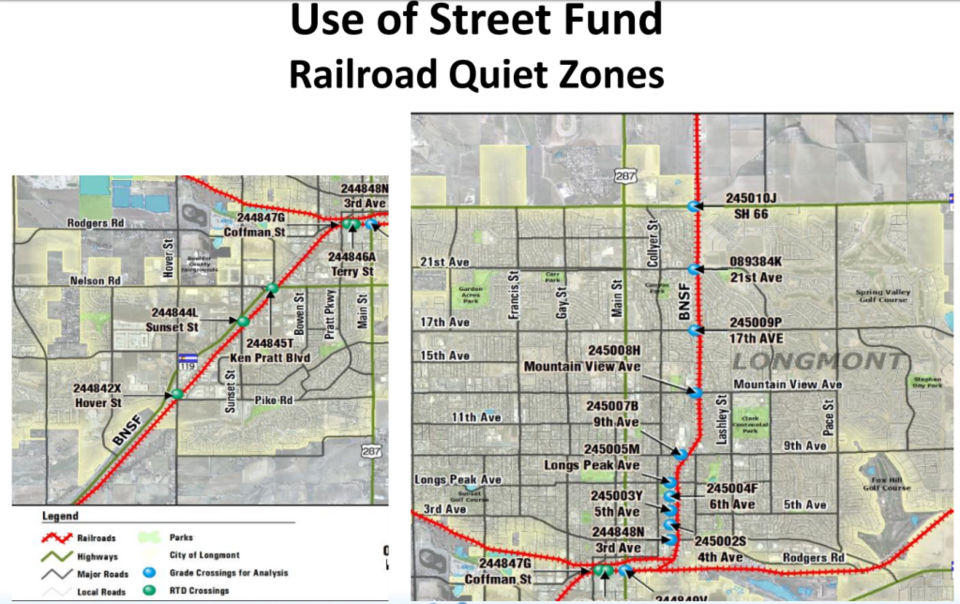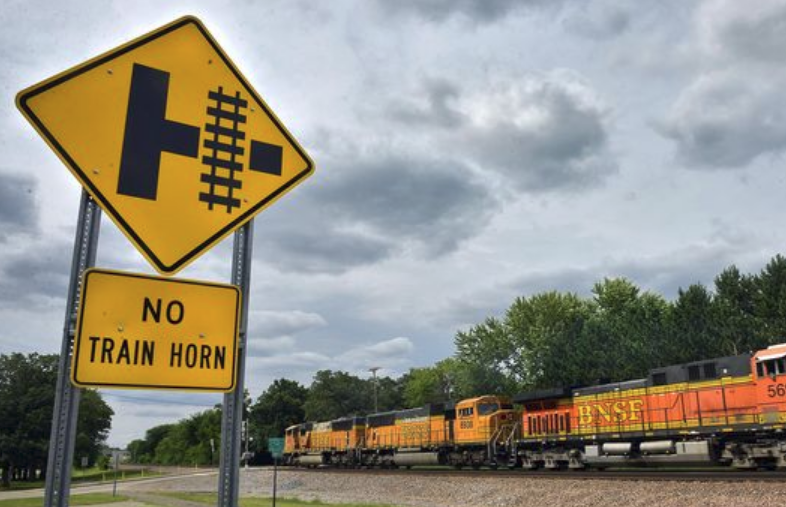This content was originally published by the Longmont Observer and is licensed under a Creative Commons license.
On Wednesday, 9/18/18, the Longmont City Council had a study session where they discussed the railroad quite zone issue for Longmont railroad crossings.
During the approximately one and a half hour discussion, the city council and city staff went deeply into what quiet zones are, how they work, how many the city needs, their costs and when the city can make them happen.
A recent study by the city estimated the cost of creating quiet zones across Longmont to be approximately $7,000,000 at the high end. It should be noted that this study was done in an effort to reflect estimated costs in 2016 and that the estimate for completing the project in 2019 may be higher. This would cover:
17 active crossing
14 Crossing Improvement Projects
3 street closures

The city staff, specifically Dale Rademacher, Director of Public Works, talked about adding and cutting programs and showing a list of capital projects in the 2019 budget that are "on the table to be reduced" if we wanted to fund other areas. He went on to make a case for making the street tax fund permanent to pay for future projects, such as Quiet Zones.
He said that could be done by increasing the funding for this project from the current $30,000 to $300,000. He said he wanted to engage the entire community in the discussion on how to implement quiet zones.
Rademacher emphasized that shifting funds from other projects, such as taking care of city streets and infrastructure, could have negative consequences. He suggested that the city should continue soliciting for grants to pay for projects like the quiet zones. Thus far, all attempts for these types of grants have not been successful.
He then asked for direction from the council on how to adjust the budget to meet the needs of the council. Mayor Bagley then said, "Let's tackle the quiet zone project first."
Council member Marcia Martin commented that "no one wants the Pike Road improvements, so there's a million dollars." One of her constituents brought up a less expensive approach of using wayside horns, as Boulder is doing. Rademacher said those systems do not significantly lessen noise and wouldn't be acceptable in a residential neighborhood.
Mayor Pro Tem Polly Christensen asked if the change in the laws that made the trains so loud, starting in 2005, actually lowered deaths caused by trains, as was intended? Rademacher replied, yes. She then went on to say, "If you go in other places in the world you don't have trains laying on the horns." Rademacher mentioned that the reason train conductors use the horns this way was because Congress stepped in. Cities across the country were passing ordinances stopping trains from using horns, which was considered dangerous.
Council member Waters suggested that city staff make a priority list. Included in that list, council member Waters wants to see a comparison of up-front costs versus the costs of re-allocating funds from other projects. He stressed that it was also important to include not only council's goals, but also others' goals, such as those of Envision Longmont, and to be able to compare them. He had some comments as well as several questions.
Waters pointed out that the costs of designing, planning, and public engagement for the train noise problem would be around $300,000 and that having the planning process completed could assist in winning a Tiger Grant.
They then spent some time discussing the plan for closing 3 intersections (Terry, Coffman, and 5th or 6th ave). Note: Coffman can no longer be closed due to other projects.
Waters then asked what the $2.2 million in 'contracted professional services' was made up of. City staff said they moved it over to capital or operating expenses that could then be, if needed, capitalized. It was effectively a 'placeholder' and used as needed for this, or related projects, at the city staff discretion. Waters' point had been made, likely for future reference, as discussions of real costs came up in the future.
Council member Aren Rodriguez then asked how it was possible you could take that $300,000 out of the current budget without any impact. Rademacher said "We'll do $300,000 less in chip fills, or overlays or some other project in 2019," but that it was both what council wanted and it's something staff understood needed to be done as long as it wasn't an ongoing thing.
Council member Martin said that after talking to staff, she understood the need to plan it and not break ground until 2020, but that the planning and budget accounting didn't make sense. Rademacher said if you ask 3 engineers for an answer, you'll get three different answers. He then said we needed the $300,000, plus the already allocated $80,000, to ensure they had enough without having to come back for more later.
Martin then asked when we would be ready to have public conversations. Rademacher said, effectively, when we're ready, "sooner rather than later" which would be spring of next year (2019).
She then said a "really solid design" is what the $300,000 should get us and set us up to start with in 2020. Martin further wanted to know, how do we push money into the 2020 budget so we don't have to find it all from scratch next September?
Rademacher said, "It depends on how we fund it and how quickly we'll do it." The planning process will shape the expectations of what can be done, how long it will take and how much it'll cost. To go faster, you're going to have to cut deeper into other programs now.
City Manager Harold Dominguez said this process was different because you had to work with at least a couple of other outside entities, including the railroad (BNSF), who have to approve the project. This can, sometimes, take years.
Council member Finley asked about long-term funding. She asked if we made the street tax permanent, could we fund the quiet zones? Rademacher said "Yes, if we also bonded for the money." He then said the council could bond up to $6 million without an election. Finley said if prop 110 passed, and we did some marijuana tax money, we could do quiet zones rather quickly. She would like to see this on the ballot in 2019.
Mayor Brian Bagley then said he would vote for quiet zones, but, this needed to be said— that anyone who buys a house on Atwood should know that a train was going to be passing by that house on a regular basis; that they knew that the train would be there and it would be loud.
He then said there was an opportunity cost. We could spend those $6 million dollars, instead, on things like affordable housing or soup kitchens or swimming pools or community centers, etc. We could do a lot with $6 million dollars. There are lots of people that would say they wouldn't want us to spend that money that way. He then asked why shouldn't the people reaping the financial rewards from this quiet zone be the ones to pay for it through something like a Metro District (in effect, a special tax district specific to that geographic area).
He said the people's property values would increase due to this. Would a Metro District be possible?
Is it fair to give the people who live here this 'windfall'?
City Manager Dominguez said the area is also home to some of the lowest of the low-income areas of the city and that it would be a burden to, likely, the wrong people.
Bagley said, again, people living along this line would get a windfall if we did this.
 An audience member watching online commented: "Should we charge people a tax that have houses near parks or golf courses that the city built because it makes their houses worth more?"
An audience member watching online commented: "Should we charge people a tax that have houses near parks or golf courses that the city built because it makes their houses worth more?"
Rademacher said that the train tracks had been a dividing point for the community for a long time (implying one side was low income, one wasn't) and that we had a chance to effectively erase that line and make all our communities more equitable. He also said that doing this would make all the crossings much safer for all the residents of Longmont, something that benefits everyone. We're all crossing those tracks at some point.
Bagley again said he'd vote for it, but that he had heard people say what Rademacher had just said.
Dominguez then pointed out that the FRA (Federal Railroad Administration) passed new rules in 2005 requiring longer and much louder horns and that before that date, the noise wasn't an issue.
Council Member Joan Peck then pointed out that the St. Vrain Mining project, if it's allowed, means many, many more trains than what we even have now. She said we should extend the street tax and we should look at the marijuana tax as a potential revenue source as well.
Council member Finely's earlier motion was again brought up, which she repeated "To make the street tax permanent without raising taxes."
Council member Waters then asked if he could add a friendly amendment. He would add several components. They decided to first vote on Finely's original motion and passed it unanimously.

Council member Water then made several motions:
- Direct staff to allocate $380,000 to analysis/planning/design and public engagement on quiet zones. This passed unanimously.
- Direct staff to bring the result with a recommendation by no later than July 1st, 2019. He said the reason was a ballot question had to be made by the first week in August, so council would need it by then. It would also give them time to determine what the sources are to actually fund it. The city manager said he'd like it by June 1st and that we should look at bonding as well. This passed unanimously.
- By July 1st, 2018 the staff brings the council a plan and an alternative, to fund quiet zones to begin construction in 2020. This passed unanimously.
- Council Member Peck moved that the city use the other half of marijuana tax to fund quite zones. This failed with Peck and Waters voting for, the rest of the council against.
- Direct staff to make no commitments to the other half of the Let's Go Colorado money to any other project until we decided to use that money and, potentially, use it for quiet zones. This passed with Finely, Bagley, and Christensen against.
The entire discussion can be viewed below:
https://youtu.be/PUoHtjCzEsE?t=2h8m56s


